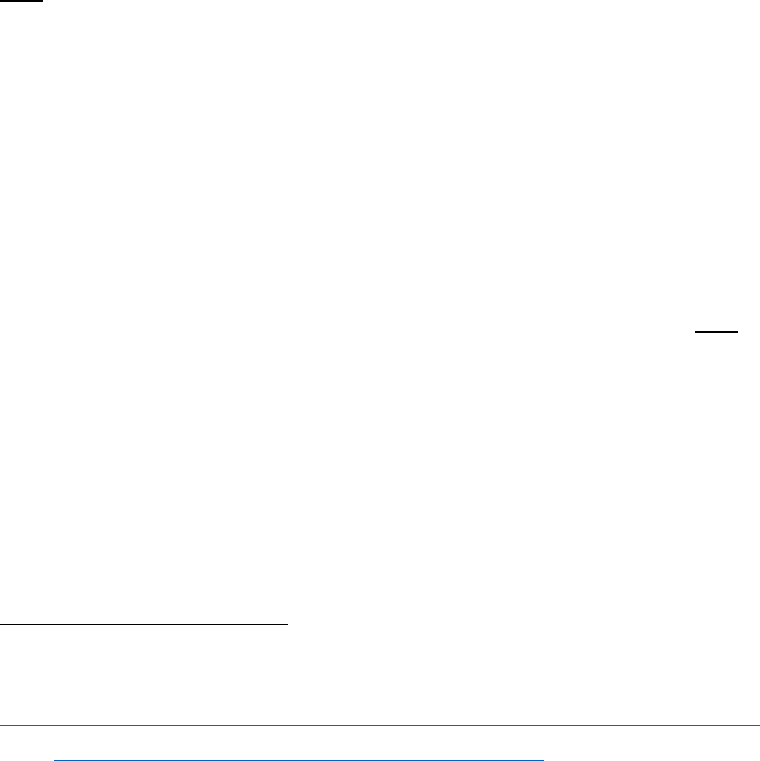Relief for Qualified Opportunity Funds and Investors Affected by Ongoing Coronavirus
Disease 2019 Pandemic
Notice 2020-39
I. PURPOSE
This notice provides relief under section 7508A(a) of the Internal Revenue Code
(Code) for qualified opportunity funds (QOFs) and their investors in response to the
ongoing Coronavirus Disease 2019 (COVID 19) pandemic. This notice also addresses
the application of certain relief provisions in the Income Tax Regulations under section
1400Z-2 of the Code (section 1400Z-2 regulations). Part III of this notice (i) provides
relief for certain failures by a QOF to meet the 90-percent investment standard and (ii)
postpones the time periods for satisfying certain other requirements. Part IV of this
notice confirms that (i) the 24-month extension for the working capital safe harbor and
(ii) the 12-month extension for QOFs to reinvest certain proceeds, both as provided
under the section 1400Z-2 regulations, are available to otherwise qualifying QOFs and
qualified opportunity zone businesses.
II. BACKGROUND
A. Emergency Declaration and Prior Grants of Relief
On March 13, 2020, the President of the United States issued an emergency
declaration under the Robert T. Stafford Disaster Relief and Emergency Assistance Act
(Stafford Act) (42 U.S.C. 5121 et seq.) in response to the ongoing COVID-19 pandemic

2
(Emergency Declaration
1
). The Emergency Declaration instructed the Secretary of the
Treasury “to provide relief from tax deadlines to Americans who have been adversely
affected by the COVID-19 emergency, as appropriate, pursuant to 26 U.S.C. 7508A(a).”
Subsequent to the Emergency Declaration, the President issued major disaster
declarations under the authority of the Stafford Act with respect to all 50 states, the
District of Columbia, and 5 territories (Major Disaster Declarations).
2
The Major
Disaster Declarations declared that, beginning on January 20, 2020, major disasters
existed in each of these jurisdictions, within which is located every population census
tract designated as a qualified opportunity zone under section 1400Z-1 of the Code.
See Notice 2018-48, 2018-28 I.R.B. 9 (Nov. 21, 2018), and Notice 2019-42, 2019-29
I.R.B. 352 (October 10, 2019) (which collectively list every designated qualified
opportunity zone).
Section 7508A provides the Secretary of the Treasury or his delegate (Secretary)
with authority to postpone the time for performing certain acts under the internal
revenue laws for a taxpayer determined by the Secretary to be affected by a Federally
declared disaster, as defined in section 165(i)(5)(A) of the Code. See section
165(i)(5)(A) (defining “Federally declared disaster” to mean “any disaster subsequently
determined by the President of the United States to warrant assistance by the Federal
Government under the Robert T. Stafford Disaster Relief and Emergency Assistance
Act”). Pursuant to section 7508A(a), a period of up to one year may be disregarded in
1
See March 13, 2020, letter from the President to Secretaries of the Departments of Homeland Security,
the Treasury, and Health and Human Services and the Administrator of the Federal Emergency
Management Agency, available at
https://www.whitehouse.gov/wp-content/uploads/2020/03/LetterFromThePresident.pdf
.
2
See https://www.fema.gov/coronavirus/disaster-declarations.

3
determining whether the performance of certain acts is timely under the internal revenue
laws.
On April 9, 2020, the Department of the Treasury and the Internal Revenue
Service issued Notice 2020-23 to provide relief under section 7508A(a) to taxpayers
affected by the COVID-19 emergency by postponing due dates with respect to certain
taxpayer and government acts. See generally Part III of Notice 2020-23 (providing relief
for certain time-sensitive actions due to be performed on or after April 1, 2020, and
before July 15, 2020), amplifying Notice 2020-20, 2020-16 I.R.B. 660 (April 13, 2020)
and Notice 2020-18, 2020-15 I.R.B. 590 (April 6, 2020), and modifying Rev. Proc. 2014-
42, 2014-29 I.R.B. 192 (July 1, 2014).
B. 180-Day Investment Requirement for QOF Investors
Section 1400Z-2(a)(1)(A) provides that, if a taxpayer has “gain from the sale to,
or exchange with, an unrelated person of any property held by the taxpayer” the
taxpayer may elect to exclude from gross income for the taxable year “so much of such
gain as does not exceed the aggregate amount invested by the taxpayer in a [QOF]
during the 180-day period beginning on the date of such sale or exchange” (180-day
investment requirement). Section 1.1400Z2(a)-1 provides definitions and rules to
implement the 180-day investment requirement.
One of the time-sensitive acts postponed by Notice 2020-23 was the making of
“an investment at the election of a taxpayer due to be made during the 180-day period
described in section 1400Z-2(a)(1)(A) of the Code” (180-day investment period). See
Notice 2020-23, Part III.A and C. Specifically, Notice 2020-23 postponed to July 15,

4
2020, any deadline for the 180-day investment requirement that otherwise would have
occurred on or after April 1, 2020 and before July 15, 2020. See id., Part III.C.
C. 90-Percent Investment Standard for QOFs
Section 1400Z-2(d)(1) defines a QOF as any investment vehicle organized as a
corporation or a partnership for the purpose of investing in qualified opportunity zone
property (other than another QOF). This definition also requires a QOF to hold at least
90 percent of its assets in qualified opportunity zone property, determined by the
average of the percentage of qualified opportunity zone property held by that QOF as
measured (i) on the last day of the first 6-month period of the taxable year of the QOF,
and (ii) on the last day of the taxable year of the QOF. See section 1400Z-2(d)(1). The
requirement that the average percentages of the QOF’s qualified opportunity zone
property on these two dates (semi-annual testing dates) must equal at least 90 percent
of the QOF’s assets is referred to as the 90-percent investment standard. See section
1400Z-2(f). Section 1.1400Z2(d)-1 provides definitions and rules to implement the 90-
percent investment standard.
If the average of the percentages of the qualified opportunity zone property held
by a QOF on these semi-annual testing dates fails to meet the 90-percent investment
standard, section 1400Z-2(f)(1) provides a general rule that the QOF must pay a penalty
for each month that the QOF fails to meet that standard. However, section 1400Z-
2(f)(3) provides that no such penalty is imposed “with respect to any failure if it is shown
that such failure is due to reasonable cause.”

5
D. Working Capital Safe Harbor for Qualified Opportunity Zone Businesses
An entity must meet certain requirements to be a qualified opportunity zone
business, including the requirement of section 1397C(b)(8) that less than 5 percent of
the average of the aggregate unadjusted bases of the entity’s property be attributable to
nonqualified financial property, as defined in section 1397C(e). Section 1397C(e)
excludes from nonqualified financial property reasonable amounts of working capital
that are held in cash, cash equivalents, or debt instruments with a term of 18 months or
less. See § 1.1400Z2(d)-1(d)(3)(iv).
The section 1400Z-2 regulations provide qualified opportunity zone businesses
with a safe harbor for treating an amount of working capital as reasonable for purposes
of section 1397C(e) if certain requirements are satisfied (working capital safe harbor).
See § 1.1400Z2(d)-1(d)(3)(v) (providing the scope of the working capital safe harbor
and conditions for eligibility). One of those requirements is that there is a written
schedule consistent with the ordinary start-up of a trade or business for the expenditure
of the working capital assets within 31 months of the receipt by the business of the
assets. See § 1.1400Z2(d)-1(d)(3)(v)(B). A qualified opportunity zone business may
extend the working capital safe harbor period to a maximum 62-month period under
§ 1.1400Z2(d)-1(d)(3)(vi) if certain additional requirements are met.
If such qualified opportunity zone business is located in a qualified opportunity
zone within a Federally declared disaster (as defined in section 165(i)(5)(A)), the
qualified opportunity zone business may receive not more than an additional 24 months
to expend its working capital assets, as long as the qualified opportunity zone business
otherwise meets the requirements of the working capital safe harbor. See

6
§ 1.1400Z2(d)-1(d)(3)(v)(D). Therefore, a qualified opportunity zone business may, if
each applicable requirement of § 1.1400Z2(d)-1(d)(3)(v) and (vi) is satisfied, have up to
a maximum 86-months to expend working capital assets if the qualified opportunity
zone business is located in a qualified opportunity zone within a Federally declared
disaster.
E. 30-Month Substantial Improvement Period for QOFs
Section 1400Z-2(d)(2)(D)(i) provides that tangible property is treated as qualified
opportunity zone business property if the tangible property is used in a trade or
business of the QOF and satisfies three general requirements. One of these
requirements is that the original use of post-2017 acquired tangible property in the
qualified opportunity zone must begin with the QOF (referred to as the “original use
requirement”), or the QOF must substantially improve that property (substantial
improvement requirement). See section 1400Z-2(d)(2)(D)(i)(II). The substantial
improvement requirement is met only if, during any 30-month period beginning after the
date of acquisition of the post-2017 acquired tangible property, there are “additions to
basis with respect to such property” held by the QOF that, in the aggregate, exceed the
QOF’s adjusted basis of that property as of the beginning of that 30-month period (30-
month substantial improvement period). See section 1400Z-2(d)(2)(D)(ii).
Section 1.1400Z2(d)-2(b)(4) provides rules to implement the substantial improvement
requirement.
F. 12-Month Reinvestment Period for QOFs
The section 1400Z-2 regulations provide generally that, if (i) a QOF sells or
disposes of some or all of its qualified opportunity zone property or if a distribution with

7
respect to the QOF’s qualified opportunity zone stock is treated as a return of capital in
the QOF’s hands, and if (ii) the QOF reinvests some or all of the proceeds in qualified
opportunity zone property by the last day of the 12-month period beginning on the date
of the distribution, sale, or disposition, then the proceeds, to the extent that they are so
reinvested, are treated as qualified opportunity zone property for purposes of the 90-
percent investment standard. See § 1.1400Z2(f)-1(b)(1). This treatment is available to
a QOF only to the extent that, prior to the reinvestment in qualified opportunity zone
property, the reinvested proceeds are continuously held in cash, cash equivalents, or
debt instruments with a term of 18 months or less. See id.
If the QOF's plan to reinvest some or all of the above-described proceeds in
qualified opportunity zone property is delayed due to a Federally declared disaster (as
defined in section 165(i)(5)(A)), the QOF may receive not more than an additional 12
months to reinvest the proceeds, provided that the QOF invests the proceeds in the
manner originally intended before the disaster. See § 1.1400Z2(f)-1(b)(2).
III. GRANTS OF RELIEF FOR QOF INVESTORS AND QOFS
A. 180-Day Investment Requirement for QOF Investors
If the last day of the 180-day investment period within which a taxpayer must
make an investment in a QOF in order to satisfy the 180-day investment requirement
falls on or after April 1, 2020, and before December 31, 2020, the last day of that 180-
day investment period is postponed to December 31, 2020. This relief is automatic;
taxpayers do not have to call the IRS or send letters or other documents to the IRS to
receive this relief. However, a taxpayer will still need to make a valid deferral election in
accordance with the instructions to Form 8949, complete Form 8997, and file the

8
completed Form 8949 and Form 8997 with a timely filed Federal income tax return
(including extensions) or amended Federal income tax return for the taxable year in
which the gain would be recognized if section 1400Z-2(a)(1) did not apply to defer
recognition of the gain. For additional information, see https://www.irs.gov/form8949
and https://www.irs.gov/form8997.
B. 90-Percent Investment Standard for QOFs
In the case of a QOF whose (i) last day of the first 6-month period of the taxable
year or (ii) last day of the taxable year falls within the period beginning on April 1, 2020,
and ending on December 31, 2020, any failure by that QOF to satisfy the 90-percent
investment standard for that taxable year of the QOF is--
(1) due to reasonable cause under section 1400Z-2(f)(3); and
(2) disregarded for purposes of determining whether the QOF or any otherwise
qualifying investments in that QOF satisfy the requirements of section 1400Z-2 and the
section 1400Z-2 regulations for any taxable year of the QOF.
This relief is automatic; QOFs do not have to call the IRS or send letters or other
documents to the IRS to receive this relief. However, a QOF must accurately complete
all lines on Form 8996 filed with respect to each affected taxable year EXCEPT that the
QOF should place a “0” in Part IV, Line 8 (Penalty). The accurately completed Form
8996 must be filed with the QOF’s timely filed Federal income tax return (including
extensions) for the affected taxable year(s). For additional information, see
https://www.irs.gov/form8996

9
C. 30-Month Substantial Improvement Period for QOFs and Qualified
Opportunity Zone Businesses
For purposes of the substantial improvement requirement with respect to
property held by a QOF or qualified opportunity zone business, the period beginning on
April 1, 2020, and ending on December 31, 2020, is disregarded in determining any 30-
month substantial improvement period (that is, the 30-month substantial improvement
period is tolled during the period beginning on April 1, 2020, and ending on December
31, 2020).
IV. REGULATORY EXTENSIONS FOR WORKING CAPITAL SAFE HARBOR AND
QOF REINVESTMENT PERIOD DUE TO FEDERALLY DECLARED DISASTERS
A. Working Capital Safe Harbor for Qualified Opportunity Zone Businesses
As a result of the Emergency Declaration (that is, the declaration of a Federally
declared disaster for purposes of section 165(i)(5)(A)), all qualified opportunity zone
businesses holding working capital assets intended to be covered by the working capital
safe harbor before December 31, 2020, receive not more than an additional 24 months
to expend the working capital assets of the qualified opportunity zone business, as long
as the qualified opportunity zone business otherwise meets the requirements of
§ 1.1400Z2(d)-1(d)(3)(v) (that is, the requirements to qualify for the working capital safe
harbor). See § 1.1400Z2(d)-1(d)(3)(v)(D) (providing such 24-month extension due to a
Federally declared disaster).
B. 12-Month Reinvestment Period for QOFs
If any QOF’s 12-month reinvestment period includes January 20, 2020 (that is,
the date of the disaster identified in the Major Disaster Declarations), that QOF receives

10
up to an additional 12 months to reinvest in qualified opportunity zone property some or
all of the proceeds received by the QOF from the return of capital or the sale or
disposition of some or all of the QOF’s qualified opportunity zone property, provided that
the QOF satisfies the requirements of § 1.1400Z2(f)-1(b)(1) and invests the proceeds in
the manner originally intended before January 20, 2020. See § 1.1400Z2(f)-1(b)(2)
(providing such 12-month extension due to a Federally declared disaster).
V. EFFECT ON OTHER DOCUMENTS
Notice 2020-23 is modified.
VI. DRAFTING INFORMATION
The principal author of this notice is Kyle C. Griffin of the Office of Associate
Chief Counsel (Income Tax and Accounting). For further information regarding this
notice, you may call the COVID-19 Disaster Relief Hotline at (202) 317-5436 (not a toll-
free number). For further information regarding the application of this notice to
section 1400Z-2 and the section 1400Z-2 regulations, please contact Mr. Griffin at
(202) 317-4718 (not a toll-free call).
